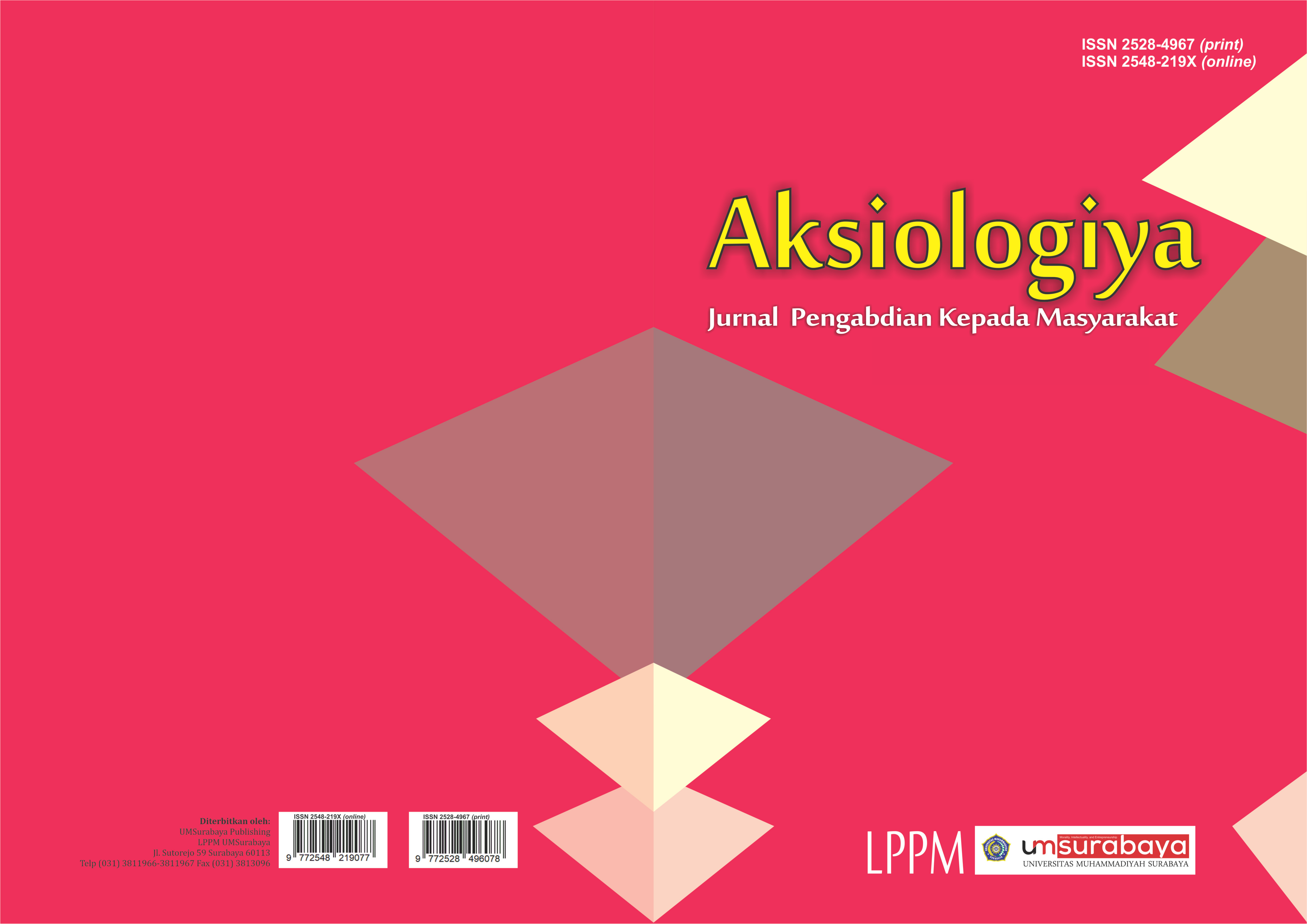Isi Artikel Utama
Abstrak
BNPB (2012) stated that casualties affected from the year 1815-2011 continue to increase. The disaster that struck Indonesia destroyed the development that has grown with great difficulty. Such conditions can cause both material and immaterial losses. The most disadvantaged are the marginalized and the poor. MLHPB (2016) states every rainy season Sampang is sure to be drowned by the flood. Data collected by MLHPB in Dalpenang and Rong Tengah were expressed as 35.4% of people suffering from leptospirosis, 60.3% of people suffering from pyoderma or ulceration, and the remaining 4.3% are inactive, lower, and diarrhea. This becomes a complex problem and there is no clear step to overcome the routine problem of it. In addition, interrupted, the distribution of drugs and. The established regulation is also considered ineffective. Need an active role of the community who are members of Posyandu Emergency Response to overcome the above problems. The methods undertaken in IbM's activities are posyandu building and disaster response. Disaster response programs ranging from the mitigation phase to the rehabilitation phase with extension and training approaches involving traditional leaders as mass mobilisers. The result of this IBM Service Activity is 80% of participants are able to understand the counseling about flood prevention and flood prevention, the cadres are able to do first aid in emergency disasters, and 80% of cadres are able to make prevention and mitigation efforts of flood. Awareness raising of disaster partners and natural disasters that are more capable and self-sufficient in facing the flood disaster each year.
Kata Kunci
Rincian Artikel
Hak cipta artikel dimiliki oleh jurnal AKSIOLOGIYA
Ciptaan disebarluaskan di bawah Lisensi Creative Commons Atribusi-NonKomersial 4.0 Internasional.
Referensi
- Ahern, M., Kovats, R. S., Wilkinson, P., Few, R., & Matthies, F. (2005). Global Health Impacts of Floods : Epidemiologic Evidence. Epidemiologic Reviews, 27, 36–46. doi:10.1093/epirev/mxi004
- Benedict, K., & Park, B. J. (2015). Invasive Fungal Infections after Natural Disasters. Emerging Infectious Disease, 20(3), 349–355.
- BNPB. (2012). Buku Saku Tanggap Tangkas Bencana.
- BNPB. (2012). Pedoman Umum Desa/Kelurahan Tangguh Bencana.
- BNPB. (2015). Rencana Nasional Penanggulangan Bencana.
- Depkes. (2001). Pedoman Penanggulangan Masalah Kesehatan akibat Kedaruratan Kompleks.
- Gosselin, R. A. (2005). War Injuries , Trauma , and Disaster Relief. Techniques in Orthopedics, 20(2), 97–108.
- Guha-sapir, D., Hoyois, P., & Below, R. (2014). Annual Disaster Statistical Review 2014 The numbers and trends.
- Habib, M., Bangsa, G., Fatkullah, M., Meytasari, Y., & Sari, R. (2012). Keefektifan PUSKESMAS bagi Masyarakat Indonesia.
- IDEP. (2007). Panduan Umum Penanggulangan Bencana Berbasis Masyarakat.
- Kemenkes RI. (2015). Rencana Strategis Kementerian Kesehatan Tahun 2015-2019.
- Lemonick, D. M. (2011). Epidemics After Natural Disasters. American Journal od Clinical Medicine, 8(3), 144–152.
- WHO. (2014). Prevention and Management of Wound Infection.
- Wuthisuthimethawee, P., Lindquist, S. J., Watters, D., & Gruen, R. L. (2014). Wound Management in Disaster Settings. World Journal of Surgery. doi:10.1007/s00268-014-2663-3
Referensi
Ahern, M., Kovats, R. S., Wilkinson, P., Few, R., & Matthies, F. (2005). Global Health Impacts of Floods : Epidemiologic Evidence. Epidemiologic Reviews, 27, 36–46. doi:10.1093/epirev/mxi004
Benedict, K., & Park, B. J. (2015). Invasive Fungal Infections after Natural Disasters. Emerging Infectious Disease, 20(3), 349–355.
BNPB. (2012). Buku Saku Tanggap Tangkas Bencana.
BNPB. (2012). Pedoman Umum Desa/Kelurahan Tangguh Bencana.
BNPB. (2015). Rencana Nasional Penanggulangan Bencana.
Depkes. (2001). Pedoman Penanggulangan Masalah Kesehatan akibat Kedaruratan Kompleks.
Gosselin, R. A. (2005). War Injuries , Trauma , and Disaster Relief. Techniques in Orthopedics, 20(2), 97–108.
Guha-sapir, D., Hoyois, P., & Below, R. (2014). Annual Disaster Statistical Review 2014 The numbers and trends.
Habib, M., Bangsa, G., Fatkullah, M., Meytasari, Y., & Sari, R. (2012). Keefektifan PUSKESMAS bagi Masyarakat Indonesia.
IDEP. (2007). Panduan Umum Penanggulangan Bencana Berbasis Masyarakat.
Kemenkes RI. (2015). Rencana Strategis Kementerian Kesehatan Tahun 2015-2019.
Lemonick, D. M. (2011). Epidemics After Natural Disasters. American Journal od Clinical Medicine, 8(3), 144–152.
WHO. (2014). Prevention and Management of Wound Infection.
Wuthisuthimethawee, P., Lindquist, S. J., Watters, D., & Gruen, R. L. (2014). Wound Management in Disaster Settings. World Journal of Surgery. doi:10.1007/s00268-014-2663-3


